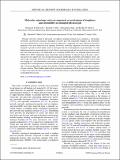Molecular anisotropy and rearrangement as mechanisms of toughness and extensibility in entangled physical gels
Author(s)
Edwards, Chelsea E. R.; Mai, Danielle J.; Tang, Shengchang; Olsen, Bradley D
DownloadPhysRevMaterials.4.015602.pdf (2.510Mb)
Terms of use
Metadata
Show full item recordAbstract
Dynamic networks formed by physically crosslinked, entangled polymers have emerged as self-healing, stretchable, and functional materials. Entangled associative gels with remarkable toughness and extensibility have been produced by several distinct chemical approaches, suggesting that these enhanced mechanical properties result from molecular-scale topology. Previously, artificially engineered associative proteins were designed to provide an ideal model system to investigate the role of entanglement on gel mechanics via well-defined entangled or unentangled physical gels. Herein, uniaxial strain-induced structural changes in these model gels were observed using in situ small-angle x-ray scattering (SAXS) and in situ polarized optical microscopy (POM) up to 2000% engineering strain. Anisotropic optical responses to uniaxial strain at the nano-, micro-, and macroscales suggest that stress dissipation mechanisms enable high extensibility and toughness. Nano- and microscopic anisotropy observed by SAXS indicate stretching and alignment of flexible polymer strands along the straining axis, and nonmonotonic macroscopic anisotropy observed by POM suggests relaxation within the hydrogel due to rearrangement of associative network junctions. Unentangled hydrogels exhibit low toughness and a strain-rate-dependent transition from ductile to brittle tensile behavior, which is typical for associative polymer solutions. These findings indicate that topological entanglements and the freedom of individual chains to align at the nanoscale due to junction relaxation are both critical to achieving high toughness and elongation in entangled physical gels.
Date issued
2020-01Department
Massachusetts Institute of Technology. Department of Chemical EngineeringJournal
Physical Review Materials
Publisher
American Physical Society (APS)
Citation
Edwards, Chelsea E. R. et al. "Molecular anisotropy and rearrangement as mechanisms of toughness and extensibility in entangled physical gels." Physical Review Materials 4, 1 (January 2020): 015602 © 2020 American Physical Society
Version: Final published version
ISSN
2475-9953